15ca4ebd4a88924e932d27301f5f0d36.ppt
- Количество слайдов: 61
 MRC Centre for Neuromuscular Disease Neuropathies associated with myeloma and other plasma cell disorders UK Myeloma Forum Meeting London November 2011 Dr Michael Lunn Consultant Neurologist and Clinical Lead in Neuroimmunology National Hospital for Neurology and Neurosurgery Queen Square London WC 1 N 3 BG michael. lunn@uclh. nhs. uk
MRC Centre for Neuromuscular Disease Neuropathies associated with myeloma and other plasma cell disorders UK Myeloma Forum Meeting London November 2011 Dr Michael Lunn Consultant Neurologist and Clinical Lead in Neuroimmunology National Hospital for Neurology and Neurosurgery Queen Square London WC 1 N 3 BG michael. lunn@uclh. nhs. uk
 There is more to neuropathy than… Common Terminology Criteria for Adverse Events v 3. 0 (CTCAE) – 2006 …. is a descriptive terminology which can be utilized for adverse event (AE) reporting. • Grades 1 -5 (minimal involvement – death) • Not really useful for neuropathy, or indeed very much neurological • There is a lot more to neuropathy than CTCAE
There is more to neuropathy than… Common Terminology Criteria for Adverse Events v 3. 0 (CTCAE) – 2006 …. is a descriptive terminology which can be utilized for adverse event (AE) reporting. • Grades 1 -5 (minimal involvement – death) • Not really useful for neuropathy, or indeed very much neurological • There is a lot more to neuropathy than CTCAE
 Neuropathies associated with plasma cell disorders • Anatomy revision • Neuropathies associated with plasma cell disorders • Typical and atypical presentations • Toxicities of treatment
Neuropathies associated with plasma cell disorders • Anatomy revision • Neuropathies associated with plasma cell disorders • Typical and atypical presentations • Toxicities of treatment
 VESALIUS, Andreas (1514 -1564) De humani corporis fabrica, Basel: Oporinus, 1543. lib. IV, pp. 353 -4 Wellcome Library, London
VESALIUS, Andreas (1514 -1564) De humani corporis fabrica, Basel: Oporinus, 1543. lib. IV, pp. 353 -4 Wellcome Library, London
 skin
skin
 Background to ‘inflammatory’ neuropathy • Paraprotein associated neuropathies part of group of inflammatory neuropathies • Diverse group of disorders with presumed ‘immune mediated’ pathogenesis • Inflammatory endoneurial infiltration and destruction of myelin and/or axons • Wide differential – Primary (eg GBS) and secondary (connective tissue diseases, paraproteinaemic etc)
Background to ‘inflammatory’ neuropathy • Paraprotein associated neuropathies part of group of inflammatory neuropathies • Diverse group of disorders with presumed ‘immune mediated’ pathogenesis • Inflammatory endoneurial infiltration and destruction of myelin and/or axons • Wide differential – Primary (eg GBS) and secondary (connective tissue diseases, paraproteinaemic etc)
 Inflammatory Peripheral Neuropathy Idiopathic Acute inflammatory demyelinating polyradiculoneuropathy (AIDP) Acute motor axonal neuropathy (AMAN) Acute motor sensory axonal neuropthy (AMSAN) a Fisher Syndrome and other regional variants Pharyngeal cervical-brachial Paraparetic Facial palsies Pure oculomotor Functional variants of GBS Pure dysautonomia Pure sensory GBS Ataxic GBS Subacute Vasculitic Neuropathy Primary vasculitis Polyarteritis nodosa and Churg -Strauss disease Wegener’s vasculitis Isolated nerve vasculitis Temporal arteritis Systemic autoimmune diseases with associated vasculitis Other Subacute inflammatory demyelinati polyradiculoneuropathy (SIDP) ng Chronic inflammatory demyelinating polyradiculoneuropathy (CIDP) Multifocal motor neuropathy with conduction block (MMNCB) Chronic relapsing axonal neuropathy Chronic ataxic sensory neuronopathy Serum sickness Infectious, malignant, related to chemotherapy Inflammatory neuropathy associated with infection HIV neuropathies, including CMV neuropathy Leprosy Lyme disease Chaga’s disease Paraproteinaem neuropathy ic Monoclonal gammopathy of undetermined significance (MGUS) Multiple myeloma Solitary plasmacytoma Lymphoma or chronic lymphocytic leukaemia Waldenström’s macroglobulinaemia Cryoglobulinaemia Cold agglutinin disease Primary amyloidosis POEMS syndrome Rheumatoid arthritis Systemic lupuserythematosus Sjörgren’s syndrome Mixed connective tissue disease Paraneoplastic Sub-acute sensory neuropathy/neuronopathy small cell lung carcinoma and anti. Hu Abs Other paraneoplastic tumour -antibody syndromes Metabolic Diabetic lumbo -sacral plexopathy
Inflammatory Peripheral Neuropathy Idiopathic Acute inflammatory demyelinating polyradiculoneuropathy (AIDP) Acute motor axonal neuropathy (AMAN) Acute motor sensory axonal neuropthy (AMSAN) a Fisher Syndrome and other regional variants Pharyngeal cervical-brachial Paraparetic Facial palsies Pure oculomotor Functional variants of GBS Pure dysautonomia Pure sensory GBS Ataxic GBS Subacute Vasculitic Neuropathy Primary vasculitis Polyarteritis nodosa and Churg -Strauss disease Wegener’s vasculitis Isolated nerve vasculitis Temporal arteritis Systemic autoimmune diseases with associated vasculitis Other Subacute inflammatory demyelinati polyradiculoneuropathy (SIDP) ng Chronic inflammatory demyelinating polyradiculoneuropathy (CIDP) Multifocal motor neuropathy with conduction block (MMNCB) Chronic relapsing axonal neuropathy Chronic ataxic sensory neuronopathy Serum sickness Infectious, malignant, related to chemotherapy Inflammatory neuropathy associated with infection HIV neuropathies, including CMV neuropathy Leprosy Lyme disease Chaga’s disease Paraproteinaem neuropathy ic Monoclonal gammopathy of undetermined significance (MGUS) Multiple myeloma Solitary plasmacytoma Lymphoma or chronic lymphocytic leukaemia Waldenström’s macroglobulinaemia Cryoglobulinaemia Cold agglutinin disease Primary amyloidosis POEMS syndrome Rheumatoid arthritis Systemic lupuserythematosus Sjörgren’s syndrome Mixed connective tissue disease Paraneoplastic Sub-acute sensory neuropathy/neuronopathy small cell lung carcinoma and anti. Hu Abs Other paraneoplastic tumour -antibody syndromes Metabolic Diabetic lumbo -sacral plexopathy
 Neuropathies associated with paraproteins • Monoclonal gammopathy of undetermined significance – Ig. M +/- anti. MAG paraproteinaemia – Ig. G and Ig. A – (others? ) • Waldenström’s macroglobulinaemia • Lymphoma - neurolymphomatosis • POEMS syndrome – Solitary myeloma (osseous/extraosseous – lytic/sclerotic) • Amyloidosis • Cryoglobulinaemia • Multiple myeloma
Neuropathies associated with paraproteins • Monoclonal gammopathy of undetermined significance – Ig. M +/- anti. MAG paraproteinaemia – Ig. G and Ig. A – (others? ) • Waldenström’s macroglobulinaemia • Lymphoma - neurolymphomatosis • POEMS syndrome – Solitary myeloma (osseous/extraosseous – lytic/sclerotic) • Amyloidosis • Cryoglobulinaemia • Multiple myeloma
 Paraproteinaemic neuropathies associated with MGUS • Neuropathy most commonly associated with MGUS • 3. 5% patients with myeloma have neuropathy • Up to 70% with MGUS have neuropathy • 10% patients with neuropathy have MGUS • Ig. M>Ig. G>Ig. A in association with neuropathy • Different distribution to MGUS alone • κ light chain over-represented • -light chain more often associated with malignant dyscrasia • Neuropathy with Ig. G/Ig. A most often like CIDP • Demyelinating neuropathy with Ig. M separate
Paraproteinaemic neuropathies associated with MGUS • Neuropathy most commonly associated with MGUS • 3. 5% patients with myeloma have neuropathy • Up to 70% with MGUS have neuropathy • 10% patients with neuropathy have MGUS • Ig. M>Ig. G>Ig. A in association with neuropathy • Different distribution to MGUS alone • κ light chain over-represented • -light chain more often associated with malignant dyscrasia • Neuropathy with Ig. G/Ig. A most often like CIDP • Demyelinating neuropathy with Ig. M separate
 Monoclonal gammopathy of undetermined significance (MGUS) • MGUS neuropathy often low levels of protein (0. 5 -5 g/l) and no immunoparesis • SPEP 26 -66% sensitive. Ifx up to 96% sensitive • SPEP +/- IFx (for ID) if SPEP negative Keren 1999 Arch Pathol Lab Med • IFx for Bence-Jones protein useful even if serum negative • Serum free light chains predict transformation to malignant clone RR 2. 5 (CI 1. 6 -4) Rajkumar et al Br J Haem 2004; Pratt Br J Haem 2008 • Serum free light chains have increased sensitivity (2 mg/l cf 150 mg/l) for light chain deposition disease (highly selected) but relevance in neuropathy unclear
Monoclonal gammopathy of undetermined significance (MGUS) • MGUS neuropathy often low levels of protein (0. 5 -5 g/l) and no immunoparesis • SPEP 26 -66% sensitive. Ifx up to 96% sensitive • SPEP +/- IFx (for ID) if SPEP negative Keren 1999 Arch Pathol Lab Med • IFx for Bence-Jones protein useful even if serum negative • Serum free light chains predict transformation to malignant clone RR 2. 5 (CI 1. 6 -4) Rajkumar et al Br J Haem 2004; Pratt Br J Haem 2008 • Serum free light chains have increased sensitivity (2 mg/l cf 150 mg/l) for light chain deposition disease (highly selected) but relevance in neuropathy unclear
 Neuropathies and paraproteins • Distal acquired demyelinating sensory neuropathy (DADS) • Chronic inflammatory demyelinating polyradiculoneuropathy (CIDP) • Distal length dependent (axonal/painful) sensory neuropathies • Multiple mononeuropathies
Neuropathies and paraproteins • Distal acquired demyelinating sensory neuropathy (DADS) • Chronic inflammatory demyelinating polyradiculoneuropathy (CIDP) • Distal length dependent (axonal/painful) sensory neuropathies • Multiple mononeuropathies
 Brandner S - NHNN
Brandner S - NHNN
 Brandner S - NHNN
Brandner S - NHNN
 Anti-MAG paraproteinaemic demyelinating peripheral neuropathy (DADS) • Chronic progressive sensorimotor demyelinating neuropathy – Elderly, male, ataxia and tremor
Anti-MAG paraproteinaemic demyelinating peripheral neuropathy (DADS) • Chronic progressive sensorimotor demyelinating neuropathy – Elderly, male, ataxia and tremor

 Anti-MAG paraproteinaemic demyelinating peripheral neuropathy (DADS) • Chronic progressive sensorimotor demyelinating neuropathy – Elderly, male, ataxia and tremor • Ig. M paraprotein in serum • Paraprotein has ‘anti-MAG’ activity • sees HNK-1 epitope • also on P 0, PMP 22, SGPG, SGLPG etc. • not clear which target is pathogenic in vivo ? MAG • Characteristic neurophysiology and pathology
Anti-MAG paraproteinaemic demyelinating peripheral neuropathy (DADS) • Chronic progressive sensorimotor demyelinating neuropathy – Elderly, male, ataxia and tremor • Ig. M paraprotein in serum • Paraprotein has ‘anti-MAG’ activity • sees HNK-1 epitope • also on P 0, PMP 22, SGPG, SGLPG etc. • not clear which target is pathogenic in vivo ? MAG • Characteristic neurophysiology and pathology
 Myelin separation
Myelin separation

 Widely spaced myelin
Widely spaced myelin
 Anti-MAG antibody may be pathogenic • Witebsky’s postulates not yet fulfilled – Anti-MAG antibody has defined PN target – Ig. M bound to nerve – Passive transfer to cats and chicks – Immunisation failed to produce Abs so far – Characteristic myelin pathology – ? response to treatment – or not – However disease course prolonged and eventually results in axonal loss ? alternative mechanism
Anti-MAG antibody may be pathogenic • Witebsky’s postulates not yet fulfilled – Anti-MAG antibody has defined PN target – Ig. M bound to nerve – Passive transfer to cats and chicks – Immunisation failed to produce Abs so far – Characteristic myelin pathology – ? response to treatment – or not – However disease course prolonged and eventually results in axonal loss ? alternative mechanism

 Lunn et al Brain 2002
Lunn et al Brain 2002
 Paraproteinaemic neuropathy Diagnosis and treatment
Paraproteinaemic neuropathy Diagnosis and treatment
 EFNS/PNS Recommendations 1. All patients with paraprotein and neuropathy should be assessed for a malignant plasma cell dyscrasia 2. Paraprotein more likely relevant if Ig. M, DADS or anti-MAG+ 3. Typical phenotype of Ig. M PDN recognised 4. Ig. M PDN sometimes responds to Rx but some are toxic and their use must be balanced against clinical need 5. Ig. G and Ig. A PDN may be indistinguishable from CIDP in presentation and response to Rx
EFNS/PNS Recommendations 1. All patients with paraprotein and neuropathy should be assessed for a malignant plasma cell dyscrasia 2. Paraprotein more likely relevant if Ig. M, DADS or anti-MAG+ 3. Typical phenotype of Ig. M PDN recognised 4. Ig. M PDN sometimes responds to Rx but some are toxic and their use must be balanced against clinical need 5. Ig. G and Ig. A PDN may be indistinguishable from CIDP in presentation and response to Rx
 Ig. M paraproteinaemic (anti-MAG) neuropathy treatment • Is treatment required at all? – Elderly male, mild ataxia, tremor and unsteadiness – no falls – No weakness, distal PP loss and VS to costal margin – Ig. Mκ paraprotein, and demyelinating neuropathy – Anti-MAG antibody positive >70000 Bühlmann Units Watch and wait…. You may do more good with a stick and some trainers…
Ig. M paraproteinaemic (anti-MAG) neuropathy treatment • Is treatment required at all? – Elderly male, mild ataxia, tremor and unsteadiness – no falls – No weakness, distal PP loss and VS to costal margin – Ig. Mκ paraprotein, and demyelinating neuropathy – Anti-MAG antibody positive >70000 Bühlmann Units Watch and wait…. You may do more good with a stick and some trainers…
 Ig. M paraproteinaemic (anti-MAG) neuropathy treatment • Are you treating the right thing? – – – 62 female Long history severe OA and immobility. Smoker Numb, painful red feet and ‘venous ulcers’ Pronounced distal motor loss. PP=VS/JPS loss Demyelinating neurophysiology 4 x Ig. Mκ paraproteins and anti-MAG antibodies • Vasculitis and acquired erythermalgia with vasculitic neuropathy • CD 138 <5% plasma cells but Ig. M k restricted – ‘appearances are suggestive of myeloma than lymphoplasmacytic lymphoma…Ig. M very rare’
Ig. M paraproteinaemic (anti-MAG) neuropathy treatment • Are you treating the right thing? – – – 62 female Long history severe OA and immobility. Smoker Numb, painful red feet and ‘venous ulcers’ Pronounced distal motor loss. PP=VS/JPS loss Demyelinating neurophysiology 4 x Ig. Mκ paraproteins and anti-MAG antibodies • Vasculitis and acquired erythermalgia with vasculitic neuropathy • CD 138 <5% plasma cells but Ig. M k restricted – ‘appearances are suggestive of myeloma than lymphoplasmacytic lymphoma…Ig. M very rare’
 Ig. M paraproteinaemic (anti-MAG) neuropathy treatment • Is treatment required at all? – Indications: • Haematological • • Progressive motor or sensory loss with instability Progressive and disabling tremor Younger age Shorter disease duration
Ig. M paraproteinaemic (anti-MAG) neuropathy treatment • Is treatment required at all? – Indications: • Haematological • • Progressive motor or sensory loss with instability Progressive and disabling tremor Younger age Shorter disease duration
 Ig. M paraproteinaemic (anti-MAG) neuropathy treatment • IVIG confers short term benefit – RCT – Multiple other immunosuppressants used • Melphalan, chlorambucil, cyclo +/- steroid, fludarabine • Rituximab (anti-CD 20) – promising in some studies • 8 non randomised studies– 6 (79 pts) positive (1 (3 pts) negative) • 1 RCT (Dalakas 2009) with serious flaws – reported ‘positive’ • Further RCT awaits publication (negative primary outcome) • 375 mg/m 2 usual dose – recent high dose study added improvement • Several cases of worsening • Administer in conjunction with PN service and haematology
Ig. M paraproteinaemic (anti-MAG) neuropathy treatment • IVIG confers short term benefit – RCT – Multiple other immunosuppressants used • Melphalan, chlorambucil, cyclo +/- steroid, fludarabine • Rituximab (anti-CD 20) – promising in some studies • 8 non randomised studies– 6 (79 pts) positive (1 (3 pts) negative) • 1 RCT (Dalakas 2009) with serious flaws – reported ‘positive’ • Further RCT awaits publication (negative primary outcome) • 375 mg/m 2 usual dose – recent high dose study added improvement • Several cases of worsening • Administer in conjunction with PN service and haematology
 Practical approach to Ig. G or Ig. A associated CIDP treatment • Clinical and electrophysiological diagnosis – IVIG 2 g/kg 5/7 daycase or – prednisolone 1 mg/kg po od 4 -8/52 – PEx – 5 exchanges over 5 -10 days • No response or unusual clinical features – Re-evaluate and consider targeted nerve biopsy • Treatment alternatives – (methotrexate), azathioprine, cyclophosphamide, ciclosporin, β-interferon, rituximab, Campath
Practical approach to Ig. G or Ig. A associated CIDP treatment • Clinical and electrophysiological diagnosis – IVIG 2 g/kg 5/7 daycase or – prednisolone 1 mg/kg po od 4 -8/52 – PEx – 5 exchanges over 5 -10 days • No response or unusual clinical features – Re-evaluate and consider targeted nerve biopsy • Treatment alternatives – (methotrexate), azathioprine, cyclophosphamide, ciclosporin, β-interferon, rituximab, Campath
 Alternative pathogenic mechanisms in inflammatory neuropathy • Cytokine-mediated inflammation and ischaemia in nerves – Peripheral nerve vasculitis and POEMS syndrome Images courtesy of Said and Zeman
Alternative pathogenic mechanisms in inflammatory neuropathy • Cytokine-mediated inflammation and ischaemia in nerves – Peripheral nerve vasculitis and POEMS syndrome Images courtesy of Said and Zeman
 POEMS syndrome Polyneuropathy Organomegaly Endocrine changes M-protein Skin changes 35 yrs old political analyst Flu-like illness Pain in legs Progressive areflexic flaccid quadraparesis over 7 weeks • Mild ankle swelling. Nil else on G/E • SNAPs preserved. Mixed DM and axonal motor features • Diagnosis SIDP/CIDP – motor predominant • •
POEMS syndrome Polyneuropathy Organomegaly Endocrine changes M-protein Skin changes 35 yrs old political analyst Flu-like illness Pain in legs Progressive areflexic flaccid quadraparesis over 7 weeks • Mild ankle swelling. Nil else on G/E • SNAPs preserved. Mixed DM and axonal motor features • Diagnosis SIDP/CIDP – motor predominant • •
 • IVIG x 2 – no response • Ig. G λ paraprotein – 5 g/l • VEGF >4000 pg/l • ? POEMS syndrome
• IVIG x 2 – no response • Ig. G λ paraprotein – 5 g/l • VEGF >4000 pg/l • ? POEMS syndrome

 Myelin separation
Myelin separation
 Widely spaced myelin
Widely spaced myelin
 Loosened/uncompacted myelin
Loosened/uncompacted myelin
 POEMS syndrome Polyneuropathy Organomegaly Endocrine changes M-protein Skin changes • Scheinker 1938 – PN, solitary myeloma and sclerotic pigmented skin • Crow-Fukase 1956 – Increasingly complex relationships of MM and PN • Bardwick 1980 – Coined acronym • 0. 3/100000 Japan (Arimura 2007)
POEMS syndrome Polyneuropathy Organomegaly Endocrine changes M-protein Skin changes • Scheinker 1938 – PN, solitary myeloma and sclerotic pigmented skin • Crow-Fukase 1956 – Increasingly complex relationships of MM and PN • Bardwick 1980 – Coined acronym • 0. 3/100000 Japan (Arimura 2007)
 POEMS syndrome diagnostic criteria Polyneuropathy and monoclonal plasma cell disorder present in all patients; to make diagnosis at least one other major criterion and 1 minor criterion is required. • Major Criteria • Polyneuropathy • Monoclonal plasma cell disorder (almost always λ – 95%) • Sclerotic bone lesions • Castleman disease • VEGF elevation • Minor Criteria • Organomegaly (spleno-, hepato- or lymphadenopathy) • Oedema, pleural effusion or ascites • Endocrinopathy (adrenal, thyroid, pituitary, gonadal, parathyroid, pancreatic* • Skin changes (pigmentation, nails, hair, plethora, cyanosis) • Papilloedema • Thrombocytosis or polycythaemia** • Other symptoms or signs Clubbing Weight loss Diarrhoea Low vitamin B 12 Pulmonary hypertension or restrictive lung disease • Thrombotic episodes • Hyperhydrosis • • • Possible associations • Arthralgia • Cardiomyopathy • Fever *DM and thyroid disease are very common and occurrence of one only not sufficient **Anaemia and thrombocytopaenia distinctly unusual unless Castleman disease present Dispenzieri 2007
POEMS syndrome diagnostic criteria Polyneuropathy and monoclonal plasma cell disorder present in all patients; to make diagnosis at least one other major criterion and 1 minor criterion is required. • Major Criteria • Polyneuropathy • Monoclonal plasma cell disorder (almost always λ – 95%) • Sclerotic bone lesions • Castleman disease • VEGF elevation • Minor Criteria • Organomegaly (spleno-, hepato- or lymphadenopathy) • Oedema, pleural effusion or ascites • Endocrinopathy (adrenal, thyroid, pituitary, gonadal, parathyroid, pancreatic* • Skin changes (pigmentation, nails, hair, plethora, cyanosis) • Papilloedema • Thrombocytosis or polycythaemia** • Other symptoms or signs Clubbing Weight loss Diarrhoea Low vitamin B 12 Pulmonary hypertension or restrictive lung disease • Thrombotic episodes • Hyperhydrosis • • • Possible associations • Arthralgia • Cardiomyopathy • Fever *DM and thyroid disease are very common and occurrence of one only not sufficient **Anaemia and thrombocytopaenia distinctly unusual unless Castleman disease present Dispenzieri 2007
 POEMS frequency and variability of clinical features
POEMS frequency and variability of clinical features
 POEMS Association with Castleman Disease Follicles contain dysplastic CD 21+ dendritic cells Mantle zone of ‘onion skin’ CD 20 cells
POEMS Association with Castleman Disease Follicles contain dysplastic CD 21+ dendritic cells Mantle zone of ‘onion skin’ CD 20 cells
 VEGF induced signal transduction in MM cells
VEGF induced signal transduction in MM cells
 VEGF in diagnosis • 1996 – Watanabe – greatly increased VEGF levels • 1998 …may cause increased vascular permeability • 2006 - “overproduction of VEGF. . . Is causative in almost all of the symptoms [of POEMS]”
VEGF in diagnosis • 1996 – Watanabe – greatly increased VEGF levels • 1998 …may cause increased vascular permeability • 2006 - “overproduction of VEGF. . . Is causative in almost all of the symptoms [of POEMS]”
 Proposed POEMS pathogenesis
Proposed POEMS pathogenesis
 Very high levels of VEGF probably useful in diagnosis • Not 100% sensitive or specific • Assays vary • Very high levels very suspicious in clinical context D’Souza, Dispenzieri et al. Blood. 2011; 118(17): 4663 -4665
Very high levels of VEGF probably useful in diagnosis • Not 100% sensitive or specific • Assays vary • Very high levels very suspicious in clinical context D’Souza, Dispenzieri et al. Blood. 2011; 118(17): 4663 -4665
 Longitudinal VEGF correlates with clinical condition not haematological CR D’Souza, Dispenzieri et al. Blood. 2011; 118(17): 4663 -4665
Longitudinal VEGF correlates with clinical condition not haematological CR D’Souza, Dispenzieri et al. Blood. 2011; 118(17): 4663 -4665
 “The constellation of -restricted monoclonal gammopathy, plasma cell rimming around lymphoid aggregates, and. . [JAK 2 V 617 F negative]. . megakaryocytic hyperplasia in a bone marrow is highly suggestive of… [POEMS], especially in the context of a peripheral neuropathy” Dao LN et al. Blood. 2011; 117(24): 6438 -6444
“The constellation of -restricted monoclonal gammopathy, plasma cell rimming around lymphoid aggregates, and. . [JAK 2 V 617 F negative]. . megakaryocytic hyperplasia in a bone marrow is highly suggestive of… [POEMS], especially in the context of a peripheral neuropathy” Dao LN et al. Blood. 2011; 117(24): 6438 -6444
 Treatment paradigms in POEMS • Median survival 33 months – 102 pts with 58 FU Nakanishi 1984 • Basic haematological regimens • Low CR, moderate PR rates • No RCTs • Local irradiation +/- surgery » 54%-74% response (Class IV only) • Low dose melphalan and dexamethasone » 56% - 81% response – 38% CR/43% PR » 100% neurological response – all 31 pts alive at 21/12 • Li et al. Blood. 2011; 117(24): 6445 -6449 • Steroids alone » 22% response Dispenzieri A et al Blood 2003; 101: 2496– 2506
Treatment paradigms in POEMS • Median survival 33 months – 102 pts with 58 FU Nakanishi 1984 • Basic haematological regimens • Low CR, moderate PR rates • No RCTs • Local irradiation +/- surgery » 54%-74% response (Class IV only) • Low dose melphalan and dexamethasone » 56% - 81% response – 38% CR/43% PR » 100% neurological response – all 31 pts alive at 21/12 • Li et al. Blood. 2011; 117(24): 6445 -6449 • Steroids alone » 22% response Dispenzieri A et al Blood 2003; 101: 2496– 2506
 POEMS treatment 2 • Thalidomide and lenalinamide both notable anti-IL 6 and cytotoxic to plasma cells • Bevacizumab – anti-VEGF human monoclonal • Bevacizumab or thalidomide but treatment failures, not necessarily with VEGF increase • Thalidomide (+/- bevacizumab) + low dose systemic chemotherapy Kuwabara S, Dispenzieri A et al Cochrane 2008 Issue 4
POEMS treatment 2 • Thalidomide and lenalinamide both notable anti-IL 6 and cytotoxic to plasma cells • Bevacizumab – anti-VEGF human monoclonal • Bevacizumab or thalidomide but treatment failures, not necessarily with VEGF increase • Thalidomide (+/- bevacizumab) + low dose systemic chemotherapy Kuwabara S, Dispenzieri A et al Cochrane 2008 Issue 4
 POEMS treatment 2 • Autologous PBSCT • 49 patients – all but one survived 2 years • ? 4% mortality in POEMS (vs 2% for other indications) • Treatment directed at relevant pathogenic aspects of disease with good effect Kuwabara S, Dispenzieri A et al Cochrane 2008 Issue 4
POEMS treatment 2 • Autologous PBSCT • 49 patients – all but one survived 2 years • ? 4% mortality in POEMS (vs 2% for other indications) • Treatment directed at relevant pathogenic aspects of disease with good effect Kuwabara S, Dispenzieri A et al Cochrane 2008 Issue 4
 POEMS or not POEMS?
POEMS or not POEMS?
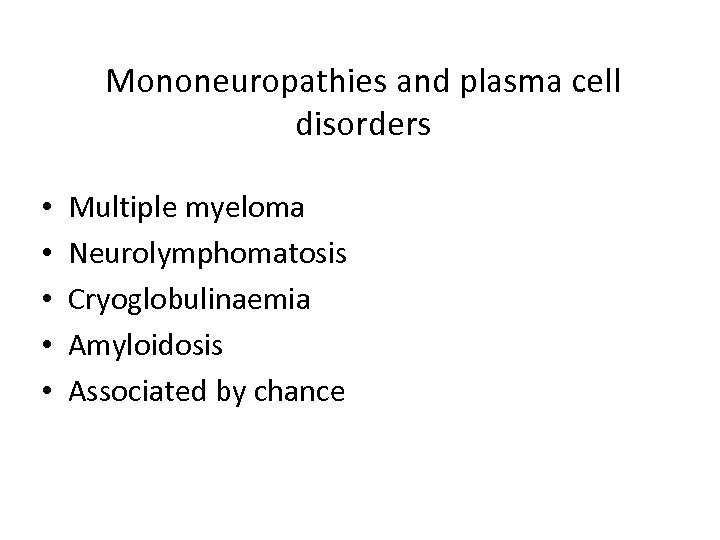 Mononeuropathies and plasma cell disorders • • • Multiple myeloma Neurolymphomatosis Cryoglobulinaemia Amyloidosis Associated by chance
Mononeuropathies and plasma cell disorders • • • Multiple myeloma Neurolymphomatosis Cryoglobulinaemia Amyloidosis Associated by chance
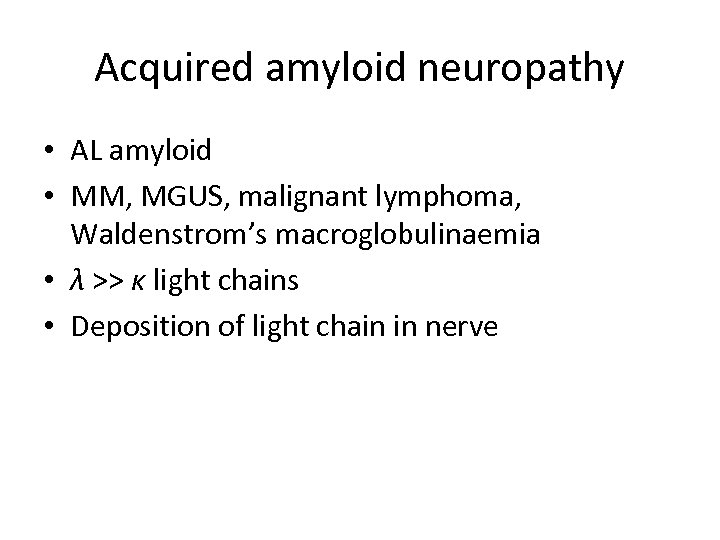 Acquired amyloid neuropathy • AL amyloid • MM, MGUS, malignant lymphoma, Waldenstrom’s macroglobulinaemia • λ >> κ light chains • Deposition of light chain in nerve
Acquired amyloid neuropathy • AL amyloid • MM, MGUS, malignant lymphoma, Waldenstrom’s macroglobulinaemia • λ >> κ light chains • Deposition of light chain in nerve
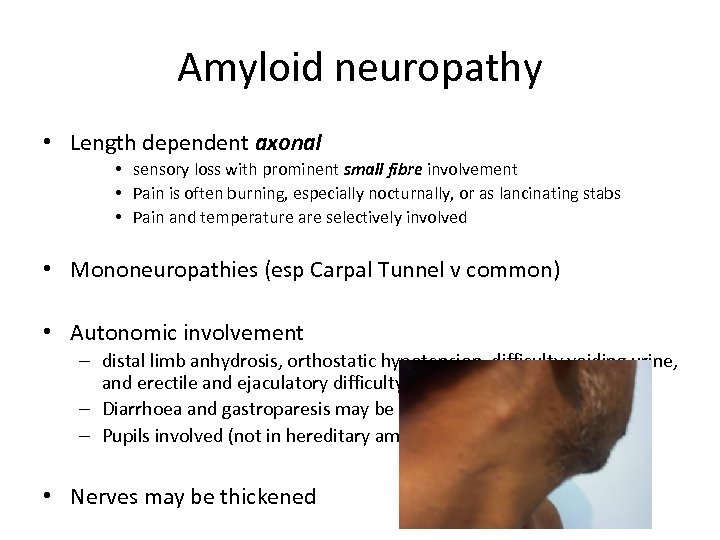 Amyloid neuropathy • Length dependent axonal • sensory loss with prominent small fibre involvement • Pain is often burning, especially nocturnally, or as lancinating stabs • Pain and temperature are selectively involved • Mononeuropathies (esp Carpal Tunnel v common) • Autonomic involvement – distal limb anhydrosis, orthostatic hypotension, difficulty voiding urine, and erectile and ejaculatory difficulty. – Diarrhoea and gastroparesis may be prominent. – Pupils involved (not in hereditary amyloid) • Nerves may be thickened
Amyloid neuropathy • Length dependent axonal • sensory loss with prominent small fibre involvement • Pain is often burning, especially nocturnally, or as lancinating stabs • Pain and temperature are selectively involved • Mononeuropathies (esp Carpal Tunnel v common) • Autonomic involvement – distal limb anhydrosis, orthostatic hypotension, difficulty voiding urine, and erectile and ejaculatory difficulty. – Diarrhoea and gastroparesis may be prominent. – Pupils involved (not in hereditary amyloid) • Nerves may be thickened
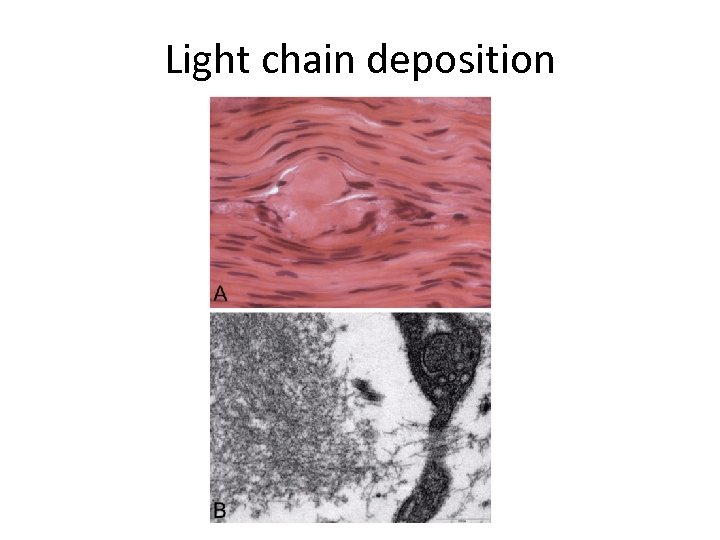 Light chain deposition
Light chain deposition
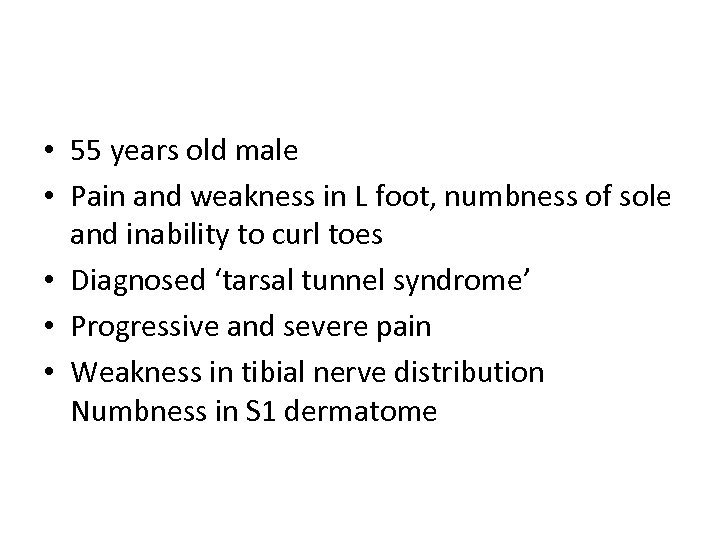 • 55 years old male • Pain and weakness in L foot, numbness of sole and inability to curl toes • Diagnosed ‘tarsal tunnel syndrome’ • Progressive and severe pain • Weakness in tibial nerve distribution Numbness in S 1 dermatome
• 55 years old male • Pain and weakness in L foot, numbness of sole and inability to curl toes • Diagnosed ‘tarsal tunnel syndrome’ • Progressive and severe pain • Weakness in tibial nerve distribution Numbness in S 1 dermatome
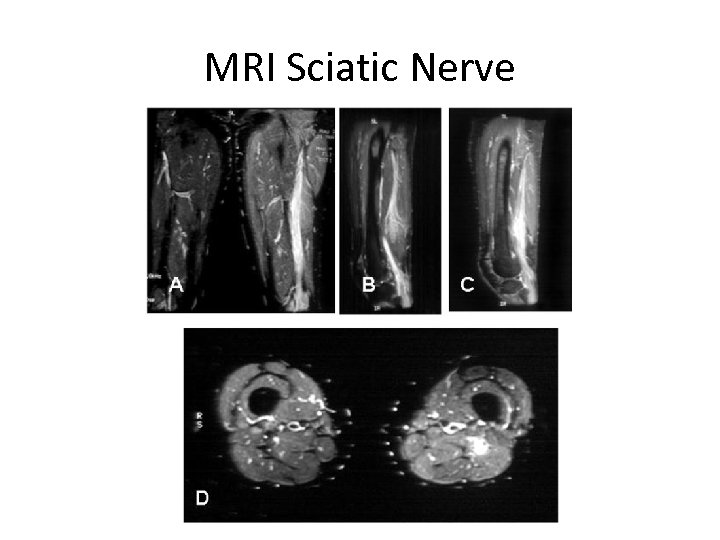 MRI Sciatic Nerve
MRI Sciatic Nerve
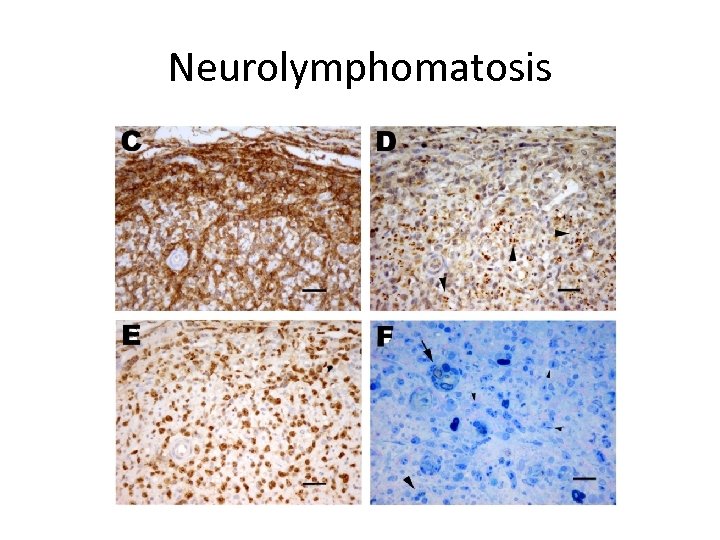 Neurolymphomatosis
Neurolymphomatosis
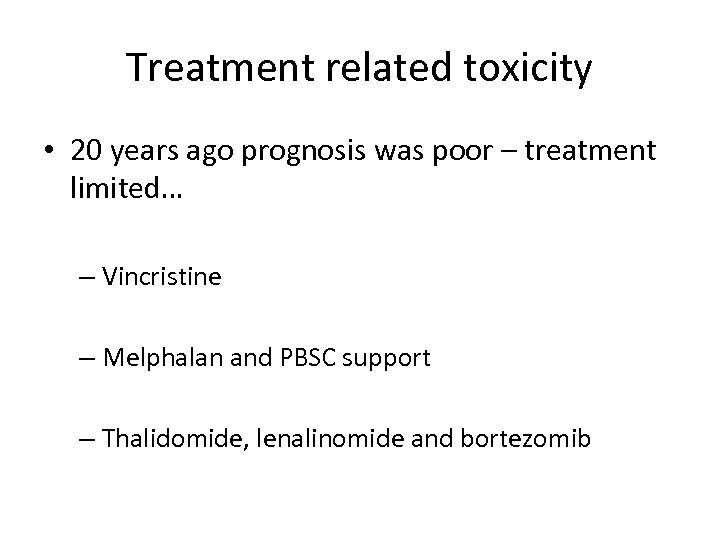 Treatment related toxicity • 20 years ago prognosis was poor – treatment limited… – Vincristine – Melphalan and PBSC support – Thalidomide, lenalinomide and bortezomib
Treatment related toxicity • 20 years ago prognosis was poor – treatment limited… – Vincristine – Melphalan and PBSC support – Thalidomide, lenalinomide and bortezomib
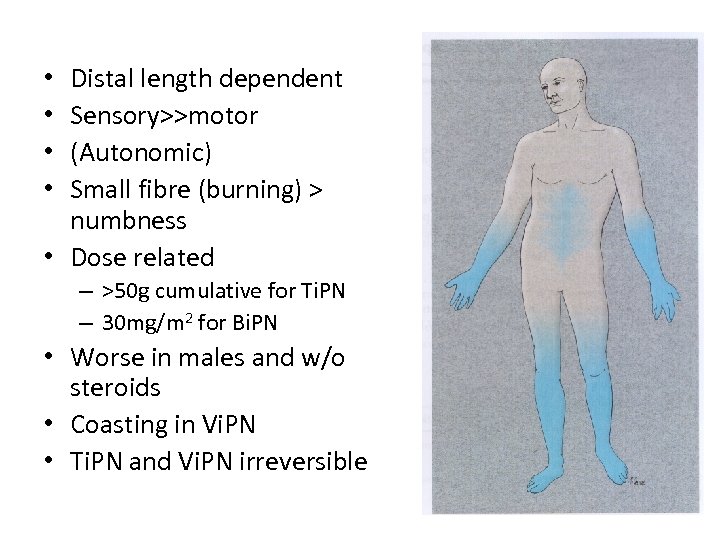 Distal length dependent Sensory>>motor (Autonomic) Small fibre (burning) > numbness • Dose related • • – >50 g cumulative for Ti. PN – 30 mg/m 2 for Bi. PN • Worse in males and w/o steroids • Coasting in Vi. PN • Ti. PN and Vi. PN irreversible
Distal length dependent Sensory>>motor (Autonomic) Small fibre (burning) > numbness • Dose related • • – >50 g cumulative for Ti. PN – 30 mg/m 2 for Bi. PN • Worse in males and w/o steroids • Coasting in Vi. PN • Ti. PN and Vi. PN irreversible
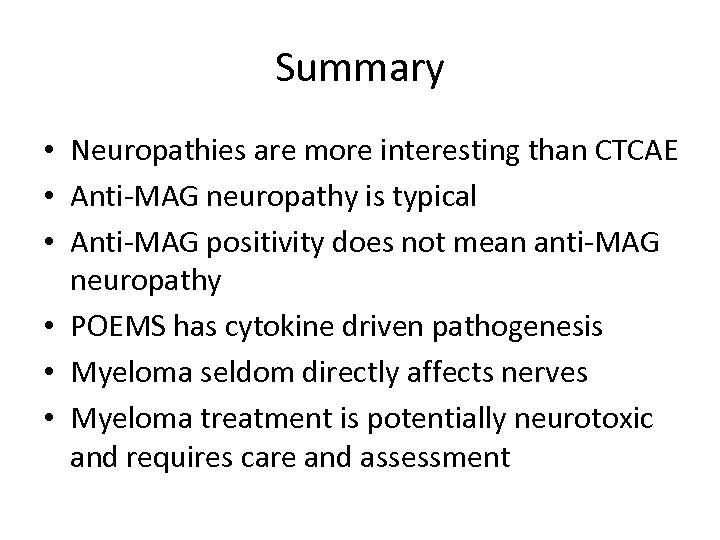 Summary • Neuropathies are more interesting than CTCAE • Anti-MAG neuropathy is typical • Anti-MAG positivity does not mean anti-MAG neuropathy • POEMS has cytokine driven pathogenesis • Myeloma seldom directly affects nerves • Myeloma treatment is potentially neurotoxic and requires care and assessment
Summary • Neuropathies are more interesting than CTCAE • Anti-MAG neuropathy is typical • Anti-MAG positivity does not mean anti-MAG neuropathy • POEMS has cytokine driven pathogenesis • Myeloma seldom directly affects nerves • Myeloma treatment is potentially neurotoxic and requires care and assessment
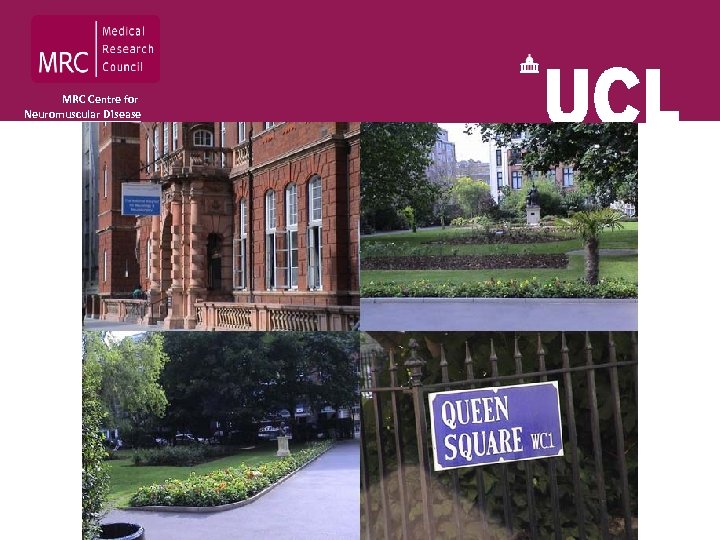 MRC Centre for Neuromuscular Disease
MRC Centre for Neuromuscular Disease


